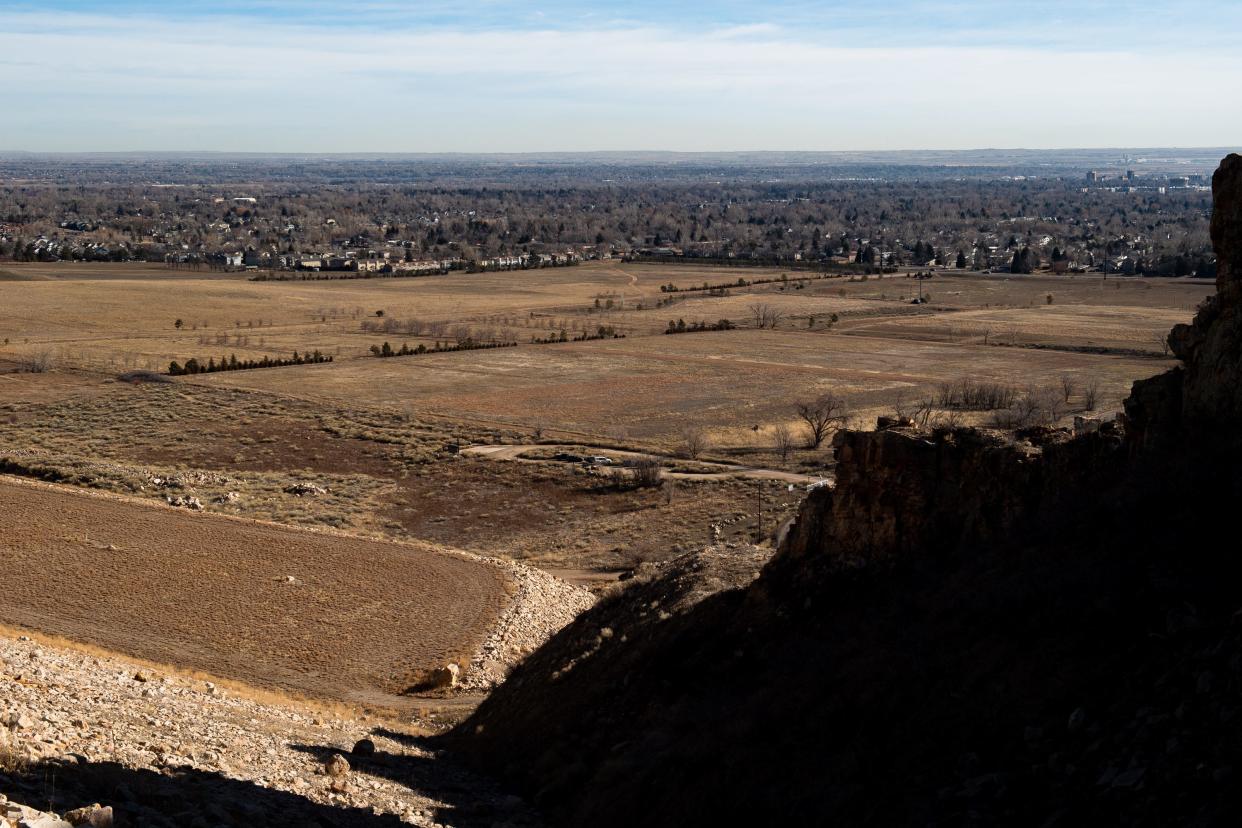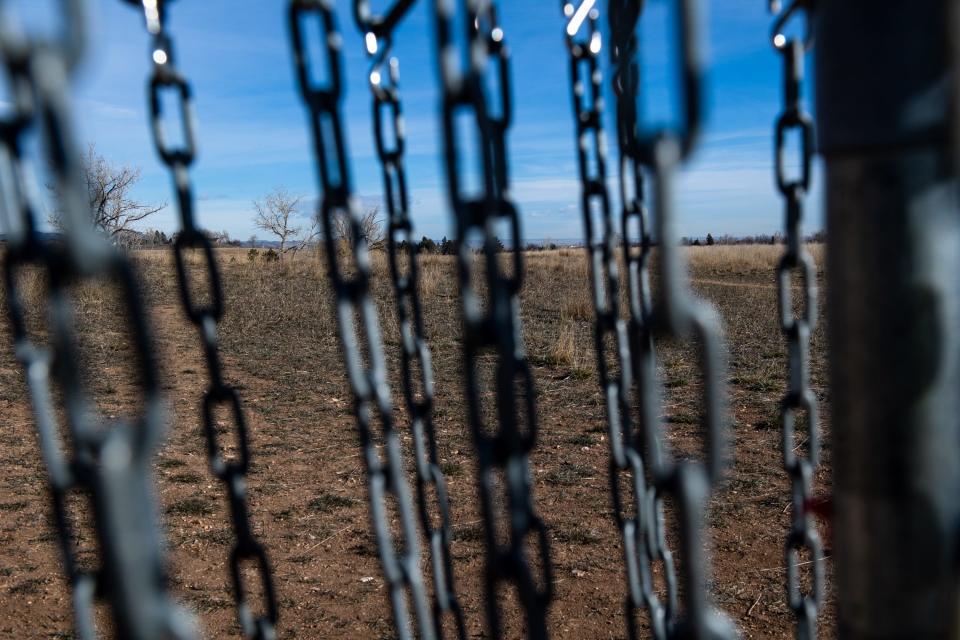City has a lot of ideas to choose from when it comes to Hughes land, and time to dig into them

Whatever the city and council decide about what to do with the land that used to house Colorado State University's former Hughes Stadium, it's clear they won't be able to please everyone.
"I'd vote for keeping it wild and as empty as possible," Debra W. said in the Coloradoan Conversations forum where we asked: What features should Fort Collins prioritize for the former Hughes Stadium property?
The next level involves some mixed uses:
"I'd like to see both pedestrian-only AND bike-only trails," Kelly B. said. "This could take some pressure off of current nearby mixed-use trails. Pedestrians could enjoy a bike-free walk/run and at the same time bikers could enjoy a pedestrian-free ride. If bikers had some more bike-specific trails to ride on, then there would be fewer bikes on nearby trails. I think this would be a win-win."
"We could ... make the remnants of the stadium a playground," Wm. R. said. "Take the north area that was the stadium and put in some type of natural look/feel park. Not like all the others but maybe some different equipment interspersed among natural grasses and flowers with wide concrete paths for wheelchairs, etc. Don't allow bikes — pedestrians only. Then take the second half and make it a natural area with maybe one pathway through it for hiking/walking, no bicycles, skateboards, etc. allowed."
And some have advocated publicly for a bike park, including social media celebrity "Dude Dad," Fort Collins-resident Taylor Calmus.
Hughes Stadium site redevelopment: Keep up with our ongoing coverage
But "There is a bike park and a dog park in nearby Spring Canyon Park," Carl C. said.
"There's a dirt bike park at Lory and at Twin Silos, too," Jessie C. said.
And "Bike park and high impact activities can be built anywhere. They do not NEED beautiful land," Jo R. said.
Diane S. noted the differing perceptions when it comes to terminology: "One of the problems with the (city) surveys is that the term 'bike park' could mean almost anything from a small, 1- to 2-acre park to the 80-acre park currently being discussed by some."
So, what exactly are open lands uses?
What uses fit most closely with the intent of the 2021 ballot measure that directed the city to pursue the purchase of the land?
Debora F. said: "Voters approved open space, not playgrounds or a bike park."
But that wasn't stipulated in the ballot language. It directed that the land be zoned as Public Open Lands for use as "property for parks, recreation, and open lands, natural areas, and wildlife rescue and restoration."
And that means different things to different people.
More: Here’s what could happen to the former Hughes Stadium site
It was difficult for conversation participants to agree on what conclusions to draw from city-initiated community surveys.
An initial survey by the city drew 2,710 responses (that's not even 2% of the city's population, by the way). Results showed that respondents prioritized a list of uses in this way:
Other: 24%
Wildlife rescue and restoration: 18%
Open lands: 16%
Parks: 16%
Recreation: 15%
Natural areas: 11%
Some people interpret the 24% saying "other" to include a large "bike park" contingent, saying that's what the highest percentage of respondents want.
But others noted that in the reverse, 43% of people want lower-impact uses with the focus on wildlife, open lands and natural areas.
"You cannot just declare that 'other' means a bike park," Mimi K. said. "The ballot measure was intended to protect the land from development. That is the best 'survey result' we have indicating the voters' preference."
The report to City Council summarized specifics this way: "High preferences were voiced for a bike park, open and natural space, mixed-use recreation space, multi-use connected trails, an Indigenous Peoples community gathering area, and maintaining the disc golf course."

In a second survey, 1,896 people responded to a question asking them what level of impact/activity they desired for the site (which gets to the level of infrastructure required, the estimated use, parking needs and more). They said:
High impact: 50%
Between medium and high impact: 10%
Medium impact: 11%
Between medium and low impact: 10%
Low impact: 20%
In this survey, the report said, "High preferences were voiced for trail connections and improvements, a bike park, a Nordic skiing course, land restoration, restrooms, and a cross country running course."
So no clear directive yet, it would seem.
Addressing the calls to keep the land natural, Derek Y. said: "That area is not natural anymore. It housed (an NCAA Division I) football stadium and a huge gravel parking lot since 1958. The cost of remediation to bring that land back to 'natural' state is astronomical ... The natural areas budget will be drained, for many years, if this is 100% a natural areas-funded project. The land is not in great shape — I recently walked the site and there was so many remnants of the old stadium's construction, demolition, etc. There are still tunnels and foundation from Hughes Stadium on that land."
The report noted that "the Natural Areas Department understands the community’s desire to see Hughes restored to meet high conservation and ecological values: and noted that "Hughes is a highly disturbed site, and it would take significant investment to preserve it. ... The ... cost of acquiring and restoring Hughes would compromise the department’s capacity and resources to acquire and/or restore other parcels of land."
How has the city done outreach so far?
The report to City Council noted there were competing interests: "Tensions will remain between interests groups, which could manifest in skepticism or distrust of this particular engagement phase."
For some, that rings true.
Jessie C. said: "The 'outreach' was a total farce.
She expressed confidence of a clear message from voters: "Conserve it as protected open space, and keep the disc golf, sledding hill, a well maintained pedestrian soft trail, and a wildlife center."
Shawnda H.'s intent in voting yes was less specific: "I voted for the acquisition to 1) prevent the land from becoming a giant slab of commercial concrete and 2) hopefully provide space for additional parks and trails. I would love to see us carve out a small portion of the acreage for a bike park while still preserving most of the property for more natural open spaces and additional trails. We should be able to compromise on a design that has something for everyone and matches the great appreciation that we all have for the outdoors."
Mimi K. expressed a feeling that the survey was flawed. "You absolutely cannot make policy based on a survey that did not use a random sample of the population. There is no way for the city to prevent people from responding more than once to these open surveys."
So what outreach has been done? A report created by consultant Kearns & West for City Council said the city's most recent period of engagement around the former Hughes Stadium property has occurred over five months. It has included:
2 surveys
Focus groups with key stakeholders
Engagement with city boards
Some of the stakeholders the city engaged were:
Planning Action to Transform Hughes Sustainably (PATHS), the group that organized the citizen-led ballot initiative
Conservation interests, like CSU’s Conservation Leadership Thru Learning program, Colorado State University’s Warner College Diversity and Inclusion Program, Wildlands Restoration Volunteers, Colorado Natural Heritage Program, Audubon Fort Collins, Save the Poudre, The High Plains Environmental Center, The Bird Conservancy of the Rockies, Colorado Open Lands, and the Sierra Club-Poudre Canyon group.
Biking groups, like Overland Mountain Biking, YourGroupRide.com, Wolfpack and Bike Fort Collins
Poudre School District
Drone park, velodrome, disc golf, and other club interests
Wildlife groups Rocky Mountain Raptor Center and Northern Colorado Wildlife Center
City of Fort Collins Parks Department, Natural Areas Department, Land Conservation and Stewardship Board, Parks & Recreation Board, Disability Advisory Board, Natural Resources Advisory Board, Native American and Indigenous community members
Communication channels also included:
A city webpage about the process
Emails and newsletter to promote the website and online engagement opportunities
A postcard mailer to 633 households surrounding the Hughes site (that's less than half a percentage of Fort Collins' population)
What happens next will be one step in a process expected to take multiple years. There is no funding allocated for projects, and two years from now, council will be approving a budget for 2025-26.
When council reviewed the report at a recent work session, city staff recommended staff continue to work with council and the public to look at possibilities.
"With this report, neither the engagement consultant, Kearns & West, nor City staff are providingrecommendations. ... These findings ideally promote a conversation among council membersthat is informed by an understanding of the variety of community interests in Fort Collins surrounding Hughes," the report said.
May the wheels of public engagement keep turning.
This article originally appeared on Fort Collins Coloradoan: Fort Collins' Hughes land ideas are plentiful, and so are opinions

